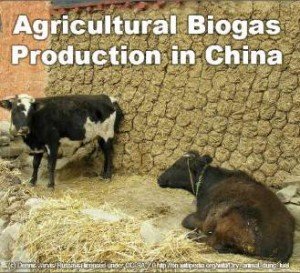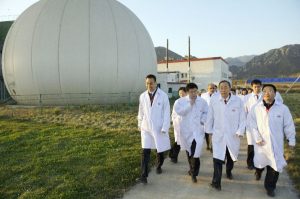Biogas production in China from agricultural organic waste is extensively utilised already and has potential to be developed further, to provide additional energy, and this is also highly sustainable energy for the nation. Most speak of Chinese biogas for the Agricultural, Domestic and Community uses. This article is limited to those applications.
Introduction
Even as long ago as the end of the 19th century, there were simple biogas digesters in operation in Southern China. 1932 saw the first biogas company opening facilities in Shanghai, with plants installed along the Yangtze River and in the southern provinces.

Over 30 million households in China have biogas digesters that convert wastes into clean-burning fuel. Biogas accounts for about 1.2% of China's total energy use, mostly replacing biomass and fossil fuels used for cooking in rural households. Biogas has 12 significant environmental and social benefits.
In China's rural areas, most villages do not have electricity, and commercial fuels like kerosene and coal are expensive. Thus the rural population still relies heavily on biological sources of energy. Fuelwood and crop residues (mostly straw) account for 80% of rural household energy use and 54% of total rural energy use. The thermal efficiency (i.e., the amount of heat actually used) is only about 10% for traditional stoves, so a lot of fuel is required for such simple tasks as preparing food and tea.
This has serious environmental consequences, such as deforestation, reduced soil fertility, erosion, and even localized desertification. It also causes severe indoor air pollution, with resultant health effects such as upper respiratory infections and eye problems. via www.ecotippingpoints.org
History of Biogas Technology in China
The first household biogas plants were installed by well-off families in the 1930s. However, biogas was not promoted extensively the time of the Great Leap Forward (1958 to 1961). Quantity was pursued over quality of the digesters and little attention was given to training and maintenance. In the 1970s there was a phase of massive campaigns and about seven million biogas plants were constructed. However, these only functioned to a minor extent due to technical defects.
 Since 1982 obligatory standards have been prescribed and applied in the construction of biogas plants. At the same time, the aggressive dissemination strategy has been cut back, scientific research has been intensified and direct subsidies have been reduced and abolished.
Since 1982 obligatory standards have been prescribed and applied in the construction of biogas plants. At the same time, the aggressive dissemination strategy has been cut back, scientific research has been intensified and direct subsidies have been reduced and abolished.
Biogas Plant Numbers Have Periodically Declined and Risen with Government Policy Changes
After the subsidies were abolished the number of plants built annually declined sharply. Beside these improvements in the diffusion strategy, many problems and high rates of failure persisted during the 1980s. Country-wide about five million household digesters were in good working order.
By 1992, Sichuan had around 1.7 million biogas plants in operation. During the 1990s, investment has increased dramatically. Over the Ninth Five-Year plan period, Chinese government invested six billion Yuan for biogas development.
By the end of the 1990s, there were 9.8 million household digesters in operation throughout China.
The National Rural Biogas Construction Plan 2003-2010
In the 2000s, the two central policies to promote biogas technology were the “National Rural Biogas Construction Plan 2003-2010”, developed in 2003 by the Ministry of Agriculture, and the “Medium and Long-Term Development Plan for Renewable Energy”, published in 2007 by the National Development and Reform Commission (NDRC). They both formulate the goals and methods of biogas promotion.
The goal for the year 2010 was that 40 million (about 16% of all rural households) households will be using biogas and their number is to double to 80 million by 2020. By 2008, about 28 million household digesters were in operation, which makes 40 million digesters a very ambitious goal.
Eleventh Five-Year Plan (2006-2010) Building a New Socialist Countryside
The Eleventh Five-Year Plan (2006-2010) and the policy of “Building a New Socialist Countryside” (shèhuìzhǔyì xīn nóngcūn jiànshè) aimed to modernize rural China while mitigating the negative impact of intensified agriculture on the environment. Renewable energy, biogas in particular, has the potential to assist this goal.
Biogas promoted Via “Three Rural Issues”, “Circular Economy Policy” etc

The Chinese government also promotes biogas systems as part of campaigns and policies like “Three Rural Issues” (sān nóng), “Circular Economy Policy” (xúnhuán jīngjì) and “Ecological Garden Projects” (shēngtài yuánlín jiànshè). It aims to combine biogas technology with agricultural production and environmental protection.
Since the end of 2008, rural biogas has been included in the national package plan that addressed the international financial crisis, and had the goal to expanded domestic demand and revive the economy.
Since 2009, substantial progress has been made in the development of rural biogas CDM projects.
A CDM methodology was developed independently by Chinese experts: “Methane recovery methodology in agricultural activities of peasant households/small scale farms” and has been recognized by CDM Executive Council. via energypedia.info
World Bank Support for Biogas Projects in China
A World Bank-supported project is helping five provinces speed up their biogas programs. Biogas also delivers significant environmental benefits in rural China.
Since 2008, the project has benefited around 500,000 rural households in 64 counties in five provinces–Anhui, Chongqing, Guangxi, Hubei, and Hunan.
Through the project, biogas digesters and stoves were installed in homes, animal sheds, toilets and kitchens built or rehabilitated to accommodate the system. via www.worldbank.org
Anaerobic Digestion Use in China is Primarily to Treat Waste – According to Chinese Government White paper
Biogas from biological wastes tops renewable energies as it also prevents carbon emissions and environmental pollution. It is at the heart of a burgeoning eco-economy in China, but certain constraints need to be addressed for its full potential to be realized.

The main reason for using anaerobic digestion, which generates biogas as a by-product, is to treat wastes. According to the government's Chinese Ecological White Paper issued in 2002, the total amount of livestock and poultry wastes generated in the country reached 2.485 billion tonnes in 1995, some 3.9 times the total industrial solid wastes. These wastes are precious resources if used properly, but constitute major pollution when discharged into rivers and lakes. It is estimated that less than 10 percent of the wastewater in China is currently treated, and that 10 million ha of farmland are seriously polluted by organic wastewater and solid wastes as well.
Estimated Availability of 130 billion m³ of Methane
According to the Chinese Academy of Sciences Geography and Resources China Natural Resources and Environment Data Bank, the total annual production of manure and night soil could theoretically generate about 130 billion m³ of methane, equivalent to 93 million tonnes of coal. While only 50 percent of the theoretical production can be realized in rural areas, 80 percent of the industrial wastewater can also be used to produce methane. via www.i-sis.org.uk
The Part Played by Chengdu Biogas Research Institute (BIOMA) in Chinese Biogas Plant Development
Mass adoption of biogas took off in 1975 when the party adopted the slogan “biogas for every household”. The famous Chengdu Biogas Research Institute (BIOMA) was founded in 1979 to disseminate this know-how locally, and on an international level.
Room for Improvement in Biogas Technology Throughout the Nation
However, there is still plenty of room for improvements from agriculture and currently at least 580m t/a agricultural (manure) and agro-industrial biodegradable wastes and waste water are thought to be available as potential sources from which biogas can be produced to supply renewable energy in China.
The agricultural production of liquid and gaseous biofuels from energy crops also holds substantial possibilities for greater biogas production in Chin in China, but is naturally controversial due to its potential to compete with food production and raise the cost of basic food commodities. The amount by which biofuels from energy crops might contribute to renewable power in China is thought to rest at about a potential 50 to 100m t/a by 2020.
This is small when compared with the possible energy which could be derived form Anaerobic Digestion and biogas production from Municipal Solid Waste (MSW).
Priority Status for Biogas in the Avoidance of GHG Emissions
Chinese authorities are giving a priority to the avoidance of GHG emissions which they appreciate does contribute to a reduction global warming. The current political structure in China is seeking to encourage the implementation of the required infrastructure jointly by local authorities, entrepreneurs and farmers. However, before this can happen substantial capacity building in the necessary process plant facilities will have to take place.
Small Scale AD Plants
China has been famous for many years for its ability to use organic wastes for biogas production on the small scale both in agriculture and within small communities.
However, it is surprising that despite the success of Anaerobic digestion and biogas production in China, at the small community scale the application of the biogas technology remains still today mostly limited to decentralised and small-scale to community scale biogas digesters in rural areas in the south and south-west of China.
Large Scale AD Plants
There is restricted experience with large-scale applications of anaerobic digestion/biogas production methods, and especially in those technologies appropriate to the cooler climates of northern China. Just a few middle and large-scale plants were built in the period since the mid-1970s, mainly motivated by rural environmental protection requirements, and biogas only considered to be a by-product. Nowadays, under renewable energy legislation recently introduced, the targets are changing to energy production as the primary purpose for these plants.
Role of Chinese Biogas in Organic Waste Utilisation Jointly with Energy Production
The authors of a paper presented to the International MBT Symposium 2007, suggest that the following are the main relevant policy drivers in China which will in the near future be instrumental in fostering organic waste utilisation jointly with energy production:
(1) ‘Circular Economy Policy inspired by Japanese and German Recycling Economy Laws and its targets till 2020, based on the ‘Cleaner Production Promotion LaW (2002) by NDRC and SEPA, including a ‘Life Cycle Assessment' approach.
(2) ‘The Renewable Energy LaW by NDRC, effective from 2006, is a framework policy, which lays out the general conditions for renewable energy to become a more important energy source, and supports various types of grid-connected renewable power generation. It includes wind, solar, water, biomass, geothermal and ocean energy. Obligations and prices are defined which enable the feed-in-grid of renewable energy into the existing power, gas or heat grids.
(3) ‘National 11th 5-Year Plan' from 2006 till 2010, aims to – increase the treatment ratio of MSW after collection from 53.5% in 2005 to 60%, which implies a capacity increase from 80m t/a to 120m t/a, till 2010, support the electricity generation from landfill gas and on the other hand set energy efficiency targets, such as to limit energy consumption per industrial output value and to promote energy saving measures.
(4) ‘China's National Rural Biogas Construction Plan', BCP by MOA (2003), has been targeting operating 15m household biogas plants (using locally self generated organic waste) by 2006, and is planned to go on to make (with 23m units in place) 20% of the all China’s farmers, biogas users by 2010.
(5) ‘Minimization of Environmental Pollution from Livestock Breeding Waste', a SEPA policy (1999) driven by the severe polluting impacts being experienced on water bodies from diffuse pollution from intensive animal farming (Xiaoyan WANG).
(6) ‘Construction of New Socialist Countryside' national policy, 2006 to boost modern agriculture, infrastructure, pubic services and the farmers' income till 2010.
All the above-mentioned policies are supporting the development of an integrated bio-organic waste management scheme in China in compliance with the renewable energy production allocated within the 11th 5-Year Plan, which ran until 2010, and the long-term targets planned through to 2020 and 2050.
Conclusion
So everything considered, China will continue to become an ever larger biogas producer and renewable power user.
China is famous for the long standing ability to use organic wastes for biogas production. It now plans to build upon this expertise to maximize the renewables potential across the nation.
With its burgeoning city population there is plenty of scope for Mechanical Biological Treatment (MBT) combined with Anaerobic Digestion of the organic fraction in China. As we explained earlier, we limited this to biogas for the Agricultural, Domestic and Community uses. Municipal MBT and similar biogas use is not part of this article, and is not discussed here.




OK. This emphasizes the significance of biogas in rural energy supply, its contribution to reducing environmental pollution, and the Chinese government’s role in supporting biogas projects to achieve sustainable energy goals. But, isn’t that just too little? They are a number one climate emitter and polluter!